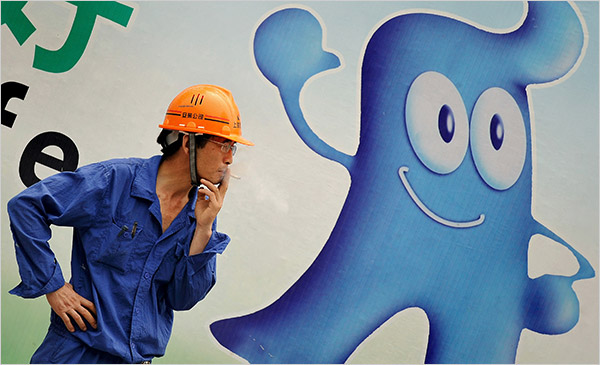|
|


ADVERTISEMENT
Buy Your own advertising
spaces!
.
Download Adobe Acrobat Reader to open [PDF] files.
Recent Visitors
Shanghai Is Sprucing Up Its Image
2009. 14 August
History has encouraged Shanghai’s people to feel a certain entitlement to the spotlight. After all, this is China’s first truly modern city, its first world city, (nytimes.com)
When Beijing won the right to hold last year’s Olympics, all of China celebrated, but somewhere in Shanghai’s heart there must have been a twinge of envy.
(nytimes.com)
When Beijing won the right to hold last year’s Olympics, all of China celebrated, but somewhere in Shanghai’s heart there must have been a twinge of envy.
Shanghai’s day in the sun is fast approaching, however. In May, it will host the 2010 World Expo, an idea with a pedigree that dates back to the 19th century and which Paris, New York and Montreal, among other metropolises before it, have used to highlight their claims to trend-setting modernity and distinctive cosmopolitanism.
For some, hosting a somewhat anachronistic event like the Expo may seem a modest consolation prize compared with the glitter of the Olympics, but that does not mean that Shanghai is approaching things with anything less than the utmost seriousness. Official Shanghai, that is. Unwilling to be outdone by China’s old capital, this city is reportedly outspending Beijing’s vast Olympic preparations by a large margin.
For months now, that has meant extraordinary things for the neighborhoods of this city. Extensive new subway lines are being rushed into service. The finishing touches are being placed on flying cloverleaf expressways. And as buildings rise like plants in some Miracle-Gro commercial, construction cranes can be seen wheeling in every direction.
Much of this theater of change is occurring in the places one would expect, like main streets of central Shanghai, where the sidewalks are being ripped up for the umpteenth time in the seven years I’ve known this town. The police, meanwhile, are already stepping up their vigilance against perceived eyesores, like the unlucky beggar I saw being escorted away after he had squatted on the sidewalk on Nanjing Road for momentary relief from the heat in the plume of chill air that streamed out of a downtown shopping mall.
Shanghai is also reportedly rushing into effect new smoking regulations aimed at bringing this tobacco-friendly city into line with increasingly widespread global standards requiring smoke-free zones in restaurants, shopping centers and other public places.
The most interesting action, though, is taking place in slightly more out-of -the-way places, namely in the neighborhoods where Shanghai’s working-class people, the masses, dwell. Many of these areas have until now been bypassed by the ongoing Chinese economic miracle, and with just a few months to go, the city is pressing an all-fronts beautification drive.
The bulldozer is the most obvious tool in this drive, with whole neighborhoods, including some of Shanghai’s most architecturally and historically interesting places, being razed after decades of woeful neglect. But this uniquely Chinese campaign has other important facets worth dwelling upon.
Anyone wondering about the roots of North Korea’s political style, with Pyongyang’s showcase boulevards and its mass games, those carefully orchestrated displays of unanimity, could do worse than to visit workers’ quarters here. Shiny new aluminum facades are being hastily stapled onto grubby family storefronts, and fresh coats of paint and mortar are being applied, often for the first time in decades. This Potemkin salubrity is regarded with frank skepticism by many locals as a gigantic, government-run “face operation.” Its aim, they say, is to impress foreign visitors, even those who wander off the beaten path, with Chinese living standards.
Another key element in the city’s drive has equally deep roots in the revolutionary past, with its endless movements and campaigns. In any of these neighborhoods, one can’t fail to be impressed by the proliferation of red propaganda banners and slogans, festooned on buildings or hanging above the streets, that exhort the masses to help promote the Expo by being more “civilized.”
But amid all of this busy re-engineering, both physical and social, Shanghai has overlooked what is perhaps the most basic campaign of all: a hospitality campaign aimed at persuading Chinese people that they are the common siblings of the rest of mankind.Why, one might ask, should there be such a need? The answer lies in the daily experience of any foreigner who wanders off the main streets, and it sometimes includes experiences on the main streets as well. Foreign visitors can often still draw stares as if freshly descended from the moon. People may talk about you in your presence, on the assumption that you don’t understand their language or, worse, that it doesn’t matter if you do. And the term “lao wai,” a less than endearing word for foreigner, hangs thickly in the air. Even the English word “hello” can take on a strange new meaning here, delivered as it sometimes is more as a sing-song taunt than as a true greeting.
The divide that lingers between the Chinese and the outside world has its roots, of course, in the political choices of the state, which has long taught people to regard foreigners with suspicion — the better to foster nationalism and control. In a chapter titled “Can We Be Friends?,” James Kynge captures this quality perceptively in his book, “China Shakes the World.” Chinese officials, he writes, are taught “that intimacy is forbidden and that making friends with foreigners is ‘work.”’
Observations like these certainly do not represent a judgment on the innate friendliness or unfriendliness of the people — Chinese, like people everywhere, come in all types, and that is indeed the point. For Shanghai, the most cosmopolitan city in the country and the one that has arguably benefited more than any other from globalization, though, the time is past due to finally de-exoticize the “other,” and as good a place to begin as any would be with a sincerely meant “hello.”
Source: www.nytimes.com

